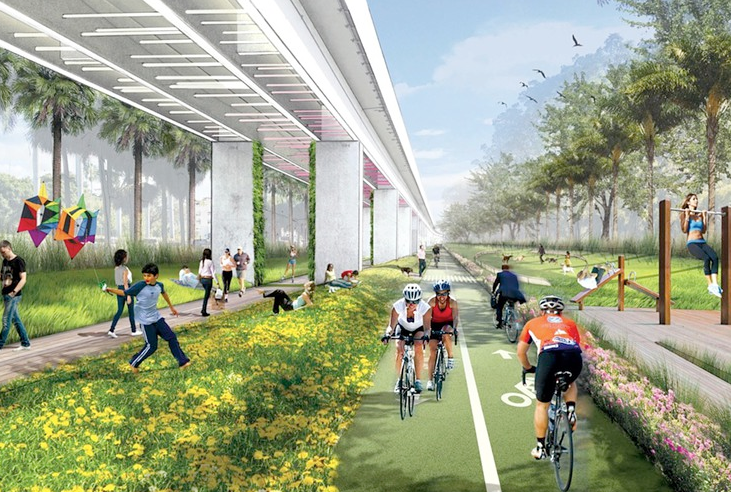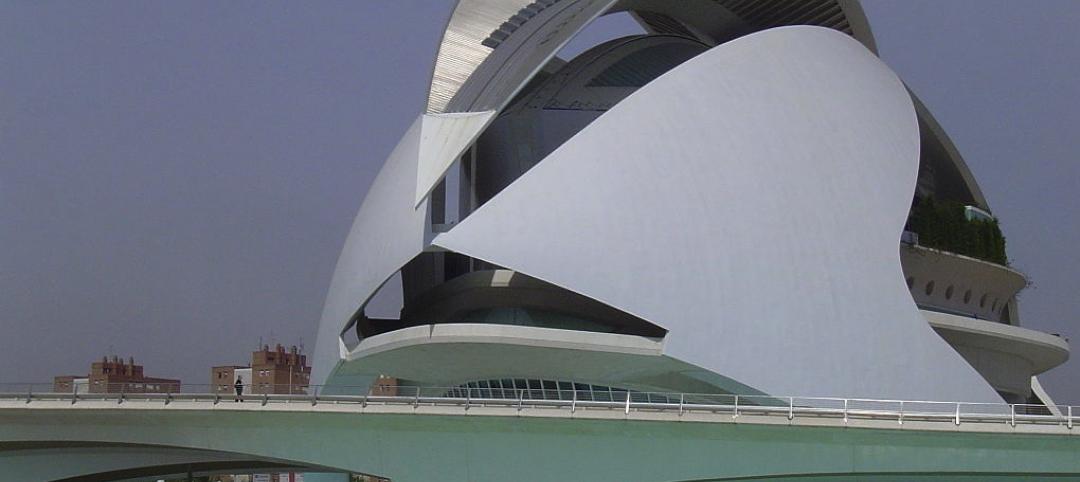A local jury in Miami has selected New York-based architectural firm James Corner Field Operations to design the master plan for The Underline bike route and lineal park.
The vision for The Underline is a 10-mile urban trail and park that would replace the underutilized M-Path, a bike path under the Metrorail tracks, from the Dadeland South Station to Brickell Station, and extend to the Miami River. It would connect communities, improve pedestrian and bicyclist safety, create acres of new green space, and attract development along US 1.
The Miami Herald reports that Field Operations will design the overall plan under a $500,000 contract that is funded by the cities of Miami, South Miami, and the Gables, along with the Knight Foundation, the Miami Foundation, the Health Foundation of South Florida and the Mitchell Wolfson Foundation.

Field Operations’ submission was chosen among entries from 19 firms.
The architect was the co-designer of the 1.45-mile High Line park, which sits atop an abandoned elevated railway on Manhattan’s West Side. Its master plan for The Underline is due in September. (A year ago, The University of Miami School of Architecture devoted a studio class of 10 students—under the direction of Professor Rocco Ceo and assisted by Arquitectonica’s Raymond Fort—and to create a preliminary concept plan for The Underline.)
The Herald reports that public and private financing sources for construction of this project have yet to be identified. The project is expected to take a decade to complete.
Related Stories
| May 29, 2014
7 cost-effective ways to make U.S. infrastructure more resilient
Moving critical elements to higher ground and designing for longer lifespans are just some of the ways cities and governments can make infrastructure more resilient to natural disasters and climate change, writes Richard Cavallaro, President of Skanska USA Civil.
| May 23, 2014
Big design, small package: AIA Chicago names 2014 Small Project Awards winners
Winning projects include an events center for Mies van der Rohe's landmark Farnsworth House and a new boathouse along the Chicago river.
| May 23, 2014
Top interior design trends: Gensler, HOK, FXFOWLE, Mancini Duffy weigh in
Tech-friendly furniture, “live walls,” sit-stand desks, and circadian lighting are among the emerging trends identified by leading interior designers.
| May 22, 2014
No time for a trip to Dubai? Team BlackSheep's drone flyover gives a bird's eye view [video]
Team BlackSheep—devotees of filmmaking with drones—has posted a fun video that takes viewers high over the city for spectacular vistas of a modern architectural showcase.
| May 22, 2014
IKEA to convert original store into company museum
Due to open next year, the museum is expected to attract 200,000 people annually to rural Älmhult, Sweden, home of the first ever IKEA store.
| May 21, 2014
Gehry unveils plan for renovation, expansion of Philadelphia Museum of Art [slideshow]
Gehry's final design reorganizes and expands the building, adding more than 169,000 sf of space, much of it below the iconic structure.
| May 20, 2014
Kinetic Architecture: New book explores innovations in active façades
The book, co-authored by Arup's Russell Fortmeyer, illustrates the various ways architects, consultants, and engineers approach energy and comfort by manipulating air, water, and light through the layers of passive and active building envelope systems.
| May 19, 2014
What can architects learn from nature’s 3.8 billion years of experience?
In a new report, HOK and Biomimicry 3.8 partnered to study how lessons from the temperate broadleaf forest biome, which houses many of the world’s largest population centers, can inform the design of the built environment.
| May 19, 2014
Calatrava wins court case concerning 'Calatrava bleeds you dry' website
A judge has ordered the left-wing political party Esquerra Unida to pay €30,000 to Santiago Calatrava because of "insulting and degrading" website.
| May 15, 2014
First look: 9/11 Memorial Museum opens to first-responders, survivors, 9/11 families [slideshow]
The 110,000-sf museum is filled with monumental artifacts from the tragedy and exhibits that honor the lives of every victim of the 2001 and 1993 attacks.
















